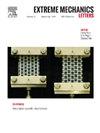Determination of high strain-rate, viscoelastic material properties of soft solids using inertial microcavitation in a thin layer
IF 4.5
3区 工程技术
Q2 MATERIALS SCIENCE, MULTIDISCIPLINARY
引用次数: 0
Abstract
Determining the high strain-rate mechanical properties of soft hydrogels and biological tissues is important for a number of biological and engineering applications but remains challenging due to the high compliance of these materials. Inertial microcavitation rheometry (IMR) is a recently developed experimental technique aimed at addressing this need and requires the optical resolution of cavitation bubble kinematics via high-speed videography. While this approach works well for optically transparent samples of dimensions much larger than the typical micron to sub-millimeter bubble sizes, IMR is challenged in highly light scattering media, such as nearly opaque tissues. One remedy to decrease the light scattering within a tissue is to prepare a thinner sample, which facilitates successful recording of the cavitation bubble dynamics. However, the thickness of the required thin samples can approach the size of the microbubbles, and the resulting confinement of the soft material layer between two boundaries changes the fundamental character of the assumed nearly infinite domain of the IMR theoretical framework, leading to erroneous material property estimates. To address this issue and to facilitate successful application of IMR to thin layers of soft materials under confinement, we developed a modified, thin-layer IMR approach for the accurate determination of high strain-rate viscoelastic material properties of soft solids that utilizes axisymmetric finite-element simulations of bubble dynamics in a thin layer. The approach is applied to two transparent, benchmark gels: 6% and 14% gelatin, and the material parameters estimated using the thin-layer IMR approach are validated against experimental data for isolated, spherical bubbles and oversized bubbles in a thin layer. The thin-layer IMR approach provides a robust methodology for applying IMR to nearly opaque, soft materials, such as tissues.
利用惯性微空化在薄层中测定软固体的高应变率粘弹性材料性能
确定软水凝胶和生物组织的高应变率机械性能对于许多生物和工程应用非常重要,但由于这些材料的高度顺应性,仍然具有挑战性。惯性微空化流变学(IMR)是一种最近发展起来的实验技术,旨在解决这一需求,并要求通过高速摄像的光学分辨率的空化气泡的运动学。虽然这种方法适用于尺寸比典型的微米到亚毫米气泡尺寸大得多的光学透明样品,但IMR在高度光散射介质(例如几乎不透明的组织)中受到挑战。减少组织内光散射的一种补救措施是制备更薄的样品,这有助于成功记录空化气泡动力学。然而,所需薄样品的厚度可以接近微泡的大小,并且由此产生的两个边界之间的软材料层的限制改变了假设的IMR理论框架的近无限域的基本特征,导致错误的材料性能估计。为了解决这一问题,并促进IMR在约束下的薄层软材料中的成功应用,我们开发了一种改进的薄层IMR方法,用于精确测定软固体的高应变率粘弹性材料特性,该方法利用薄层中气泡动力学的轴对称有限元模拟。该方法应用于两种透明的基准凝胶:6%和14%明胶,使用薄层IMR方法估计的材料参数与薄层中孤立的球形气泡和超大气泡的实验数据进行了验证。薄层IMR方法为将IMR应用于几乎不透明的软材料(如组织)提供了一种强大的方法。
本文章由计算机程序翻译,如有差异,请以英文原文为准。
求助全文
约1分钟内获得全文
求助全文
来源期刊

Extreme Mechanics Letters
Engineering-Mechanics of Materials
CiteScore
9.20
自引率
4.30%
发文量
179
审稿时长
45 days
期刊介绍:
Extreme Mechanics Letters (EML) enables rapid communication of research that highlights the role of mechanics in multi-disciplinary areas across materials science, physics, chemistry, biology, medicine and engineering. Emphasis is on the impact, depth and originality of new concepts, methods and observations at the forefront of applied sciences.
 求助内容:
求助内容: 应助结果提醒方式:
应助结果提醒方式:


